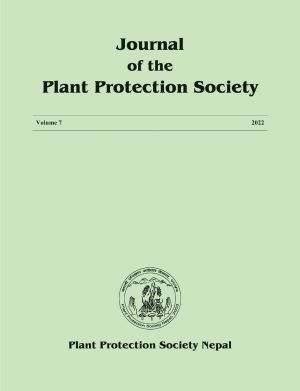Management of Tomato Diseases in Plastic House at Lamjung
DOI:
https://doi.org/10.3126/jpps.v7i01.47296Keywords:
Management measures, plastic houses, tomato, tomato diseasesAbstract
An experiment was conducted in plastic houses at three farmers’ field, each farmer as a replication, in three local levels (Sundarbazar, Gaunsahar and Besisahar) in Lamjung district during July to December 2017, to identify and manage major diseases of tomato (variety: Srijana) using chemicals and bio-pesticides. The treatments Bio-cure-B (Pseudomonas fluorescens: bio-fungicide) Bavistin Carbendazim, systemic fungicide) and Dithane M-45 (Mancozeb, contact fungicide) were applied as foliar spray. Control plot was maintained without application of any treatment. Mainly four fungal diseases, early blight (Alternaria solani), late blight (Phytopthora infestans), powdery mildew (Leveillula taurica), septoria leaf spot (Septoria lycopersici) and one bacterial disease (Xanthomonas campestris pv. Vesicatoria) were recorded. Mancozeb showed the best to control the disease incidence and severity of early blight (25%, 6.33%), late blight (18.0%, 14.34%) and septorial leaf spot (11.67%, 11.55%) repectively followed by Carbendazim, and P. fluorescens over control. However, Carbendazim was the best to control powdery mildew (6.0%, 2.0%), followed by Mancozeb and P. fluorescens over control. There were no significant effect of pesticides on bacterial leaf spot, plant height, and leaf number but
considerable variation in fungal diseases, yield and average fruit weight.
Downloads
Downloads
Published
How to Cite
Issue
Section
License

This work is licensed under a Creative Commons Attribution-NonCommercial 4.0 International License.
© Plant Protection Society of Nepal

